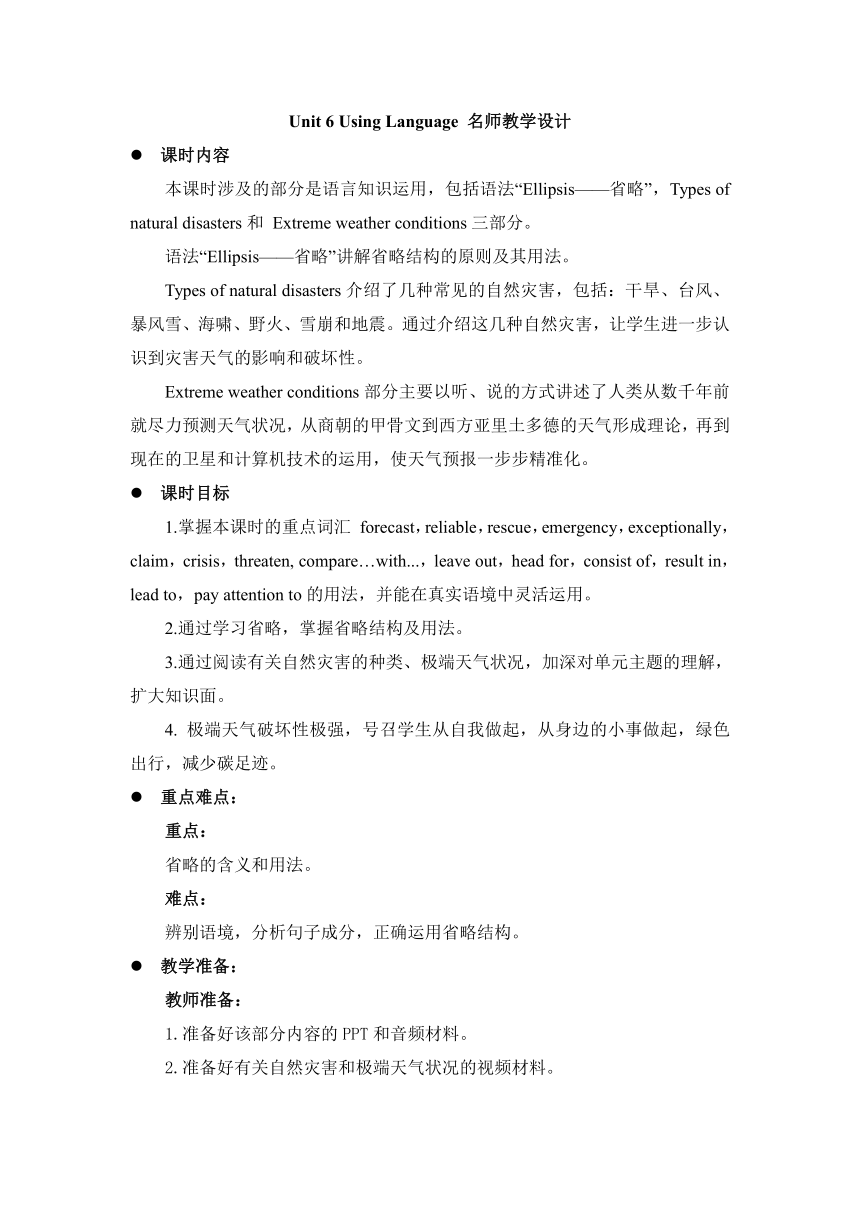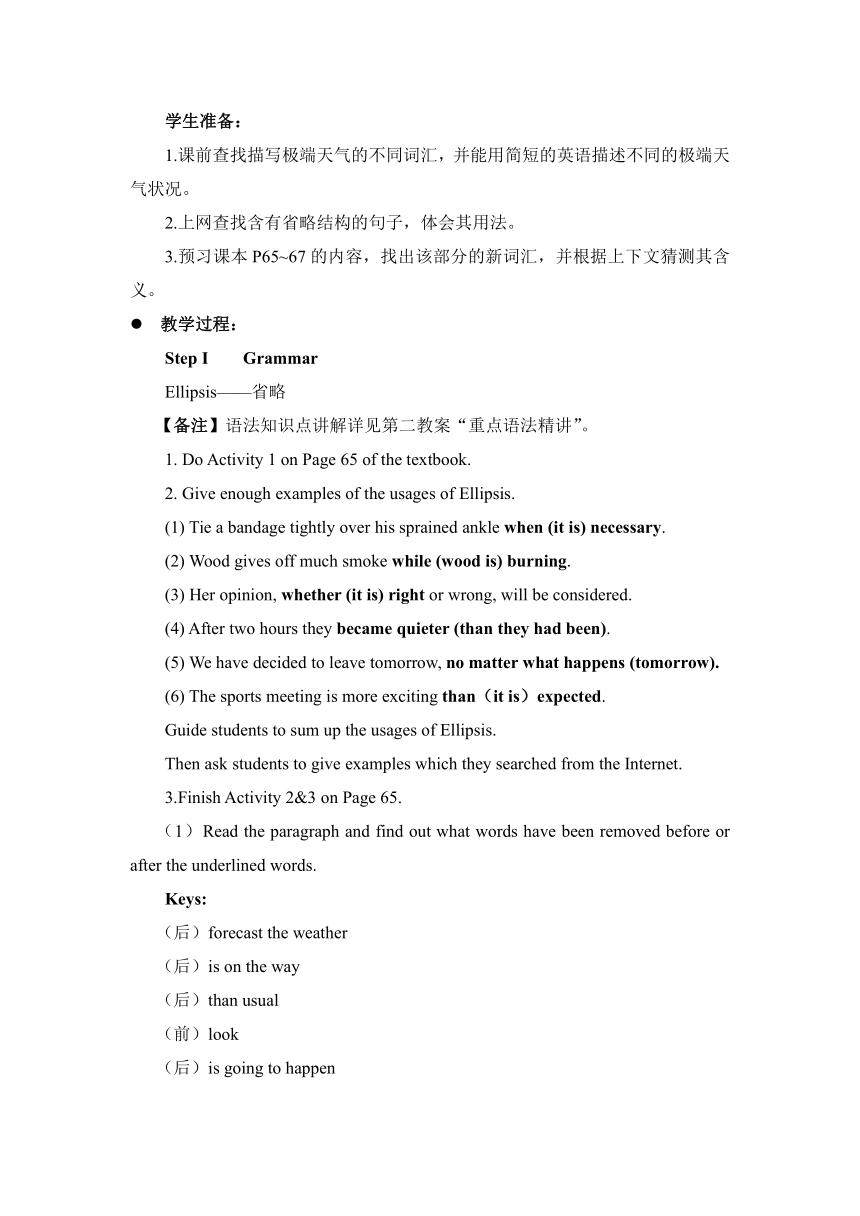外研版(2019)必修第三册 Unit6 Disaster and hope Using Language师教学设计
文档属性
| 名称 | 外研版(2019)必修第三册 Unit6 Disaster and hope Using Language师教学设计 |  | |
| 格式 | docx | ||
| 文件大小 | 18.2KB | ||
| 资源类型 | 教案 | ||
| 版本资源 | 外研版(2019) | ||
| 科目 | 英语 | ||
| 更新时间 | 2023-03-02 08:10:32 | ||
图片预览


文档简介
Unit 6 Using Language 名师教学设计
课时内容
本课时涉及的部分是语言知识运用,包括语法“Ellipsis——省略”,Types of natural disasters和 Extreme weather conditions三部分。
语法“Ellipsis——省略”讲解省略结构的原则及其用法。
Types of natural disasters介绍了几种常见的自然灾害,包括:干旱、台风、暴风雪、海啸、野火、雪崩和地震。通过介绍这几种自然灾害,让学生进一步认识到灾害天气的影响和破坏性。
Extreme weather conditions部分主要以听、说的方式讲述了人类从数千年前就尽力预测天气状况,从商朝的甲骨文到西方亚里土多德的天气形成理论,再到现在的卫星和计算机技术的运用,使天气预报一步步精准化。
课时目标
1.掌握本课时的重点词汇 forecast,reliable,rescue,emergency,exceptionally,claim,crisis,threaten, compare…with...,leave out,head for,consist of,result in,lead to,pay attention to的用法,并能在真实语境中灵活运用。
2.通过学习省略,掌握省略结构及用法。
3.通过阅读有关自然灾害的种类、极端天气状况,加深对单元主题的理解,扩大知识面。
4. 极端天气破坏性极强,号召学生从自我做起,从身边的小事做起,绿色出行,减少碳足迹。
重点难点:
重点:
省略的含义和用法。
难点:
辨别语境,分析句子成分,正确运用省略结构。
教学准备:
教师准备:
1.准备好该部分内容的PPT和音频材料。
2.准备好有关自然灾害和极端天气状况的视频材料。
学生准备:
1.课前查找描写极端天气的不同词汇,并能用简短的英语描述不同的极端天气状况。
2.上网查找含有省略结构的句子,体会其用法。
3.预习课本P65~67的内容,找出该部分的新词汇,并根据上下文猜测其含义。
教学过程:
Step I Grammar
Ellipsis——省略
【备注】语法知识点讲解详见第二教案“重点语法精讲”。
1. Do Activity 1 on Page 65 of the textbook.
2. Give enough examples of the usages of Ellipsis.
(1) Tie a bandage tightly over his sprained ankle when (it is) necessary.
(2) Wood gives off much smoke while (wood is) burning.
(3) Her opinion, whether (it is) right or wrong, will be considered.
(4) After two hours they became quieter (than they had been).
(5) We have decided to leave tomorrow, no matter what happens (tomorrow).
(6) The sports meeting is more exciting than(it is)expected.
Guide students to sum up the usages of Ellipsis.
Then ask students to give examples which they searched from the Internet.
3.Finish Activity 2&3 on Page 65.
(1)Read the paragraph and find out what words have been removed before or after the underlined words.
Keys:
(后)forecast the weather
(后)is on the way
(后)than usual
(前)look
(后)is going to happen
(后)is going to happen
(2)Remove words from the news report to make it more concise.
Keys:(略)
Step Ⅱ Types of natural disasters
1. Look at the pictures and answer the questions.
(1)Which one do you think is the most dangerous?
(2)Can you name some big natural disasters in history?
2.Complete the reports with the words in Activity 4. Pay attention to the words describing natural disasters.
Keys
1 typhoon 2 wildfire 3 avalanche 4 earthquake
5 tsunami 6 blizzard 7 drought
3.Work in pairs. Ask students to talk about a recent natural disaster they have heard about or seen on the news.
Step Ⅲ Extreme weather conditions
1.Read “Did You know ” and learn about things about extreme weather conditions.
2.Do Activity 7 & 8 on Page 67.
(1)Listen to the weather forecast and match the weather symbols to the locations on the map.
(2)Listen again and complete the form.
Keys:(略)
3.Do Activity 9 & 10 on Page 67.
(1)Act out the conversation to talk about an extreme weather condition.
(2)Choose another extreme weather condition and have a similar conversation.
【设计意图】该部分基本按照课本顺序设置活动,由浅入深,逐层加深难度,锻炼了学生读、听、写、说的能力。首先,通过读 “Did You know?”部分,了解人们对天气的预测情况。然后,通过听录音,先解决浅层的理解,再记录听力的要点,完成 Activity 7和8。接下来是说的环节,通过语言输入,学生头脑中对自然灾害、极端天气状况有了初步认识,同时掌握了该部分常见词汇和句型,再仿照上述内容进行对话练习。整个环节内容不多,但环环相扣,遵循了语言的认知规律,设置科学、合理。
Step IV Summing up
总结省略的结构和用法,并注意该部分新学词汇的运用。
Step V Homework
1. Give the students some exercises about ellipsis.
2.Master the usages of the new vocabulary.
板书设计:
Unit 1 Disaster and hope Period II Using language I. Grammar 1. Do Activity 1 on Page 65 of the textbook. 2. Give enough examples of the usages of Ellipsis. (1) Tie a bandage tightly over his sprained ankle when (it is) necessary. (2) Wood gives off much smoke while (wood is) burning. (3) Her opinion, whether (it is) right or wrong, will be considered. (4) After two hours they became quieter (than they had been). (5) We have decided to leave tomorrow, no matter what happens (tomorrow). (6) The sports meeting is more exciting than(it is)expected. Guide students to sum up the usages of Ellipsis. Then ask students to give examples which they searched from the Internet. 3.Finish Activity 2&3 on Page 65. Ⅱ. Types of natural disasters 1. Look at the pictures and answer the questions. 2.Complete the reports with the words in Activity 4. Pay attention to the words describing natural disasters. 3.Work in pairs. Ask students to talk about a recent natural disaster they have heard about or seen on the news. Ⅲ. Extreme weather conditions 1.Read “Did You know ” and learn about things about extreme weather conditions. 2.Do Activity 7 & 8 on Page 67. 3.Do Activity 9 & 10 on Page 67. IV. Summing up V. Homework
课时内容
本课时涉及的部分是语言知识运用,包括语法“Ellipsis——省略”,Types of natural disasters和 Extreme weather conditions三部分。
语法“Ellipsis——省略”讲解省略结构的原则及其用法。
Types of natural disasters介绍了几种常见的自然灾害,包括:干旱、台风、暴风雪、海啸、野火、雪崩和地震。通过介绍这几种自然灾害,让学生进一步认识到灾害天气的影响和破坏性。
Extreme weather conditions部分主要以听、说的方式讲述了人类从数千年前就尽力预测天气状况,从商朝的甲骨文到西方亚里土多德的天气形成理论,再到现在的卫星和计算机技术的运用,使天气预报一步步精准化。
课时目标
1.掌握本课时的重点词汇 forecast,reliable,rescue,emergency,exceptionally,claim,crisis,threaten, compare…with...,leave out,head for,consist of,result in,lead to,pay attention to的用法,并能在真实语境中灵活运用。
2.通过学习省略,掌握省略结构及用法。
3.通过阅读有关自然灾害的种类、极端天气状况,加深对单元主题的理解,扩大知识面。
4. 极端天气破坏性极强,号召学生从自我做起,从身边的小事做起,绿色出行,减少碳足迹。
重点难点:
重点:
省略的含义和用法。
难点:
辨别语境,分析句子成分,正确运用省略结构。
教学准备:
教师准备:
1.准备好该部分内容的PPT和音频材料。
2.准备好有关自然灾害和极端天气状况的视频材料。
学生准备:
1.课前查找描写极端天气的不同词汇,并能用简短的英语描述不同的极端天气状况。
2.上网查找含有省略结构的句子,体会其用法。
3.预习课本P65~67的内容,找出该部分的新词汇,并根据上下文猜测其含义。
教学过程:
Step I Grammar
Ellipsis——省略
【备注】语法知识点讲解详见第二教案“重点语法精讲”。
1. Do Activity 1 on Page 65 of the textbook.
2. Give enough examples of the usages of Ellipsis.
(1) Tie a bandage tightly over his sprained ankle when (it is) necessary.
(2) Wood gives off much smoke while (wood is) burning.
(3) Her opinion, whether (it is) right or wrong, will be considered.
(4) After two hours they became quieter (than they had been).
(5) We have decided to leave tomorrow, no matter what happens (tomorrow).
(6) The sports meeting is more exciting than(it is)expected.
Guide students to sum up the usages of Ellipsis.
Then ask students to give examples which they searched from the Internet.
3.Finish Activity 2&3 on Page 65.
(1)Read the paragraph and find out what words have been removed before or after the underlined words.
Keys:
(后)forecast the weather
(后)is on the way
(后)than usual
(前)look
(后)is going to happen
(后)is going to happen
(2)Remove words from the news report to make it more concise.
Keys:(略)
Step Ⅱ Types of natural disasters
1. Look at the pictures and answer the questions.
(1)Which one do you think is the most dangerous?
(2)Can you name some big natural disasters in history?
2.Complete the reports with the words in Activity 4. Pay attention to the words describing natural disasters.
Keys
1 typhoon 2 wildfire 3 avalanche 4 earthquake
5 tsunami 6 blizzard 7 drought
3.Work in pairs. Ask students to talk about a recent natural disaster they have heard about or seen on the news.
Step Ⅲ Extreme weather conditions
1.Read “Did You know ” and learn about things about extreme weather conditions.
2.Do Activity 7 & 8 on Page 67.
(1)Listen to the weather forecast and match the weather symbols to the locations on the map.
(2)Listen again and complete the form.
Keys:(略)
3.Do Activity 9 & 10 on Page 67.
(1)Act out the conversation to talk about an extreme weather condition.
(2)Choose another extreme weather condition and have a similar conversation.
【设计意图】该部分基本按照课本顺序设置活动,由浅入深,逐层加深难度,锻炼了学生读、听、写、说的能力。首先,通过读 “Did You know?”部分,了解人们对天气的预测情况。然后,通过听录音,先解决浅层的理解,再记录听力的要点,完成 Activity 7和8。接下来是说的环节,通过语言输入,学生头脑中对自然灾害、极端天气状况有了初步认识,同时掌握了该部分常见词汇和句型,再仿照上述内容进行对话练习。整个环节内容不多,但环环相扣,遵循了语言的认知规律,设置科学、合理。
Step IV Summing up
总结省略的结构和用法,并注意该部分新学词汇的运用。
Step V Homework
1. Give the students some exercises about ellipsis.
2.Master the usages of the new vocabulary.
板书设计:
Unit 1 Disaster and hope Period II Using language I. Grammar 1. Do Activity 1 on Page 65 of the textbook. 2. Give enough examples of the usages of Ellipsis. (1) Tie a bandage tightly over his sprained ankle when (it is) necessary. (2) Wood gives off much smoke while (wood is) burning. (3) Her opinion, whether (it is) right or wrong, will be considered. (4) After two hours they became quieter (than they had been). (5) We have decided to leave tomorrow, no matter what happens (tomorrow). (6) The sports meeting is more exciting than(it is)expected. Guide students to sum up the usages of Ellipsis. Then ask students to give examples which they searched from the Internet. 3.Finish Activity 2&3 on Page 65. Ⅱ. Types of natural disasters 1. Look at the pictures and answer the questions. 2.Complete the reports with the words in Activity 4. Pay attention to the words describing natural disasters. 3.Work in pairs. Ask students to talk about a recent natural disaster they have heard about or seen on the news. Ⅲ. Extreme weather conditions 1.Read “Did You know ” and learn about things about extreme weather conditions. 2.Do Activity 7 & 8 on Page 67. 3.Do Activity 9 & 10 on Page 67. IV. Summing up V. Homework
